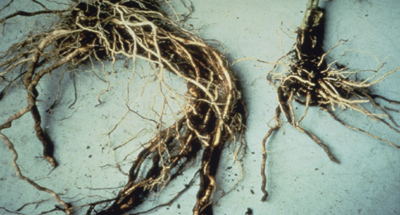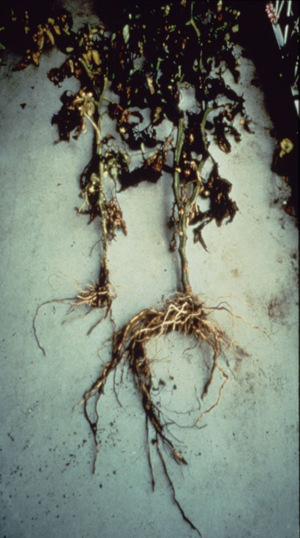The Importance and Effects of Rock Dust in Orchards and Gardens
The Importance and Effects of Rock Dust in Orchards and Gardens

Closeup of tomato roots – Remineralized plant on the left.
Fritz Leipold
Germany
Fritz Leipold has over 25 years experience with the application of basalt rock dust, especially in orchards, fruit, and vegetable gardens. He is a retired garden landscape consultant and has experience in education and teaching.
He was head of the Department for Tree Nurseries and Landscaping at the Research Training Institute, and now Technical College in Weihenstephan, and has been a teacher and advisor for vegetables, fruit, and horticulture in the area of Siegkreises since 1948. The following passages are overviews of his insights since 1950 in applying basalt rock dust to fruit and vegetable gardens.

Tomato plants after harvest – The plants and root systems of those fed with Simalith rock dust are impressively larger and more substantial.
At the very beginning of his work, Fritz Leipold proposed a 2.5-hectare test area in Hangelar on the Niederberg. It was to be a place of experimentation and instruction for the new generation of farmers. Within two years they succeeded in this undertaking with several subsidies from different organizations.
It was a very controversial project. The soil was bad, mainly sandy and with a lot of gravel. It was a birch and beech-planting region. The area had been deforested after the war by the inhabitants of the region. Some people predicted total failure of the project.
Spruce Area Remineralization
The use of basalt rock dust from Huhnerberg, today known under the trademark name Simalith played a very special role. In 1949 at the end of deforestation and beginning of the first soil treatment, Leipold took a soil sample. An average of 11 samples showed the following results:
pH = 4.8
P205 (phosphorus) = 3.2 mg in 100 g soil
K20 (potassium) = 8.2 mg in 100 g soil
A former 1/4-hectare size spruce area represented a special case. It was a typical humus soil with a pH of 3.7. It showed no growth of the plants that normally grow on agricultural land such as pioneer plants or weeds. After 20 mm of rainfall, only the top millimeters of soil were moist, a moistening factor equaling zero.
From 1949 on a first application of basalt rock dust of 3 tons per hectare was applied. In the following years 1.5 tons per hectare were applied. In the year 1952 a second analysis of the soil was done with the following result for the 11 samples taken:
pH = 5.4
P205 (phosphorus) = 3.7 mg
K20 (potassium) = 9.8 mg
Creation of Humus
In 1950 in this area an orchard of apple trees, mostly of the Cox-Orange Rennet species was planted. From 1952 onward, volunteer plants such as knotgrass began to grow. From 1955 on grasses were growing there without having been seeded.
It was a very successful transformation of the raw soil into “mild humus” through the application of basalt rock dust. Leipold writes that with these results it is possible to see the proof of the statement of the English agriculture scientist Sir Albert Howard. In his book My Agricultural Testament, after having visited the Hunzas in the Karakorma Mountains of the Himalayas, Howard writes:
“Will, through the yearly supply of finely distributed elements, an advantage be transmitted to the soil and the plants? We don’t know the composition of this loess. If it is finely distributed limestone, then its value is apparent. If for the greatest part it consists of crushed silicates then, its potential significance must still be researched. Do the mineral sediments in the soil need to be regenerated like humus? If so, then nature has given us a complete demonstration area with results that cannot be ignored.”
Sir Albert Howard
This book was written in 1939, a statement far ahead of its time. For Leipold the decisive statement is the sentence: “Do mineral sediments in the soil need regeneration, like humus?”
According to Leipold, this question must be answered in the affirmative, for our cultivated soils like our forest soils are impoverished of very fine minerals. He writes that basalt rock dust is a clay mineral of a crystalline structure. Minerals define in many ways the qualities of soil and are thereby important factors for the production potential of the soil. Because of the tiny size of the grains and their structure these clay minerals have specific surfaces, depending on the grid structure of the minerals. Ions, i.e. cations, can be attracted selectively through the ion exchange. Also, the propensity to absorb water can be extraordinarily high, depending on the mineral structure. These propensities of clay minerals create the storage capacity of the soil for water and plant nutrients, ion exchange and attachment of nutrients.
These qualities are the basis for cultivation and stabilization of the soil structure, and dependent on them are: soil moistness and aeration, erosion and conditions for cultivation. With a yearly application of basalt rock dust the soils become enriched with the minerals due to the weathering process. In forestry and extensive soil cultivation, the plants depend on such a mobilization of nutrients and this can be applied in its natural form.
Leipold has many photographs revealing dramatic results using the basalt rock dust trademark product Simalith. In one photograph he shows the condition of the Niederberg plot prior to the deforestation in 1948 and one can see the still untreated agricultural soil. Another photograph shows how the soil became alive with different grasses and weeds as well as healthy pear and peach trees. (Photos mentioned in the study are part of Research Packet available through mail order.)
Apple Orchards
Photographs (not included here) show that the apple trees of the Cox-Orange-Renette species on the former deforested area are extremely healthy. The imbalance of the soil life in the area was very great. The soil fungus Phyphotora cactorum was lacking predators. Similar conditions caused by a completely anti-natural soil treatment in the 1950s led to a great loss of trees. However, in fruit orchards in the Lower Rhine region no tree was attacked. The silicatification of the leaf surface did not allow for the Schor-infection to take hold.
Photograph (not included here) shows the artificial application and treatment of the infection (the size of pinheads). In this test the spores used up all their germinating power but were not able to intrude into the leaf and one could see the tiny spots still in the September of that year. The apple trees of the Cox-Orange-Rennet species on the former deforested area are extremely healthy. The silicatification of the leaf surface through applications of Simalith rock dust did not allow for the Schor-infection to take hold.
Strawberries
Other photographs (not included here) show a multi-annual strawberry culture mowing method.
After the harvest the weeds were growing in. Then the whole area was mowed with a mulching instrument. After the strawberries came through again they were roto-tilled to a width of between 8-10 cm (3-4 inches). The former weed growth protects as dead mulch and lies on the top supplying the organic elements.
Before the mowing 15 kg/ha(1/100 hectare) Simalith was applied. Until blossoming in the spring Simalith was blown on every ten days. It was not necessary to fight fungus disease like botrytis. The natural result was firm, ripe, fungus free fruits that keep their firmness and shiny surface after harvesting was the natural result.
Tomato Plants
Photographs show tomato plants after the harvest. The ones with Simalith are much larger and more substantial than those only fed with fertilizer.
Grain
The first application of Simalith was done in 1980 without plowing it in. The application was regularly repeated in the amount of 1.5 tons/ha. The pictures (not shown here) show clearly that after three years these fine minerals had penetrated down to a depth of 55-6 cm (22-24 inches). Additional fertilization was not done on the areas treated with Simalith.
An exception to this is that when there is frost, decomposed manure is thinly applied. Then it can be seen that if Simalith is not plowed in deeply the first time (at least a foot), the integration of minerals into the soil occurs only in the third year. Also here, the roots followed the minerals down into a depth of 60 cm (2 ft) and this already at the end of April. Additionally Simalith was sprayed three more times before the sprouting of the wheat at 750 g Simalith to 100 liters and 6-8 l/ha (liters per hectare). A spraying to shorten the stalk was not applied. The same is true for rye, which gets to a height of 1.80 m (6 ft).
Why is that so? Our grains are luxury consumers of silica. The stalks are strengthened, the stand is optimal and the deep roots guarantee this stand. A further indication is the good even development of the kernels in the grain and a smaller amount of water content of the harvested material on the average of 1-2%. The hectoliter (100 liter) weight is higher also.
From the studies done with basalt rock dust on orchards and vegetable gardens, one can conclusively state that rock dust is instrumental in producing firm ripe fruit, superb root systems and can be effective in preventing crop diseases.
|
||||||||||||||||||||||||||||||||||||||||||||||||||||||||||||||||||||||||||||||||||||||||||||
Support us on Patreon
Thank you for joining us today! Please become a member of RTE and support us on Patreon. Unlike many larger organizations, we work with a team of determined and passionate volunteers to get our message out. We aim to continue to increase the awareness of remineralization to initiate projects across the globe that remineralize soils, grow nutrient dense food, regenerate our forests’ and stabilize the climate – with your help! If you can, please support us on a monthly basis from just $2, rest assured that you are making a big impact every single month in support of our mission. Thank you!







John
November 22, 2014 (9:55 pm)
Where can I find Rock Dust (Basalt?) for a Back yard Garden in Galveston , Tx? The local Nurseries can’t find it
Joanna Campe
September 27, 2017 (3:30 pm)
Check our resource directory!